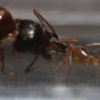Hi Newbies,
I've been at this hobby for almost exactly a year now and I've had some amazing luck at raising new colonies from the queens I've found and with very few losses. Several of my colonies have over 100 workers and are still growing fast. Based on what I've learned (mostly from the other great folks on this forum), I wanted to share with you my setup in case you're wondering how some other folks manage their new colonies.
Here is the bulk of my setup:

Basically, I have a 30 gallon aquarium and use a light bulb on a pet thermostat to keep it at roughly 27C. Then, I have sealed food storage containers each with one colony. Inside each container is a layer of dry sand, an open test tube setup, and a beverage cap containing a wad of cotton saturated with sugar water. The container in the far upper left contains all of my very small colonies (< 20 workers). I open all of the food storage containers every 2 or 3 days to refresh/replace the sugar water cotton and replace the old food with new. I also move the food and cotton around each time I open them.
This setup has worked well for me thus far, but is really only suitable for small colonies (< 100 workers). Soon I'll have to think of something else since these seem to be growing out of control.







![IMG 0490[1] IMG 0490[1]](https://www.formiculture.com/uploads/gallery/album_489/gallery_420_489_1081354.jpg)









